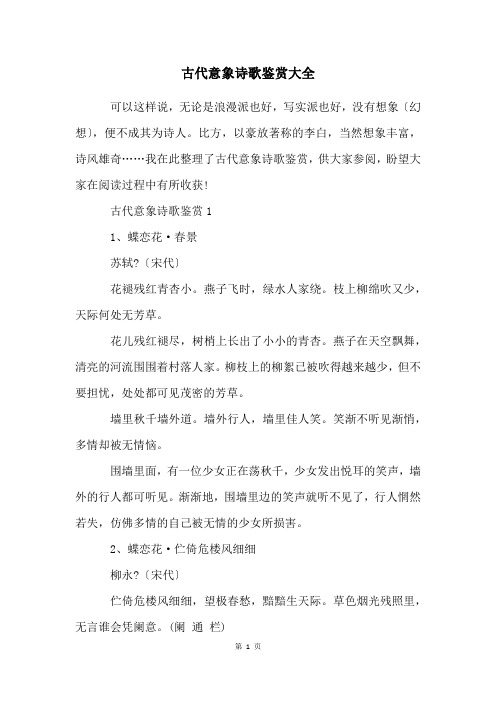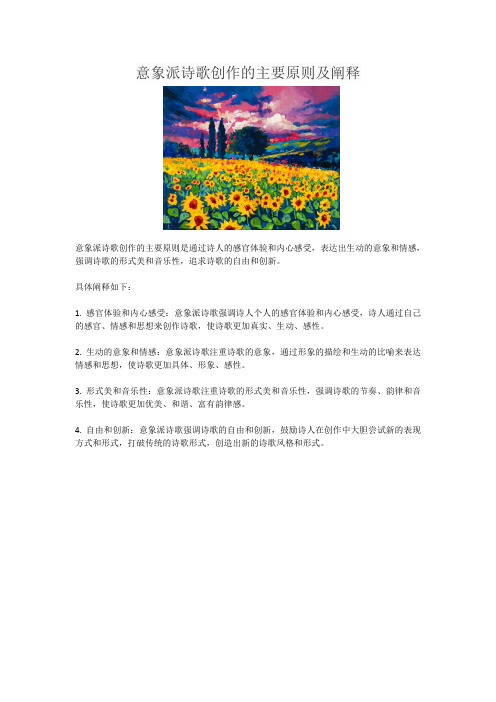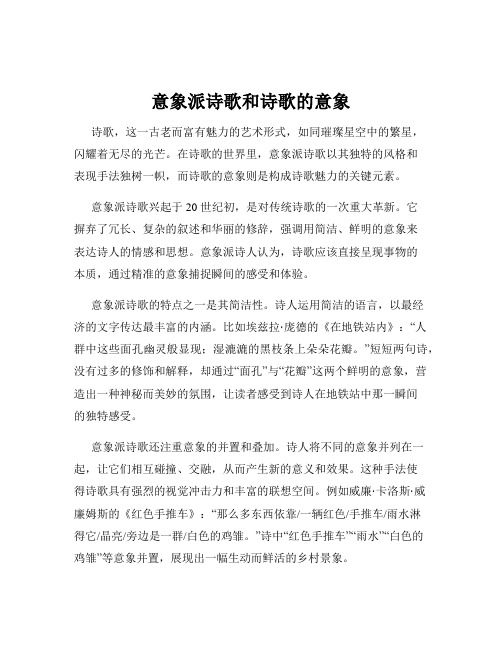意象派诗歌..
意象派诗选

意象派诗选
《意象派诗选》是一部集合了许多具有代表性的意象派诗歌作品的选集。
意象派是20世纪初期欧美文学中的一股重要诗歌流派,强调感官的直接表达和意象的传达,具有极高的艺术价值。
这部诗选包括了众多著名的意象派诗人的代表作,如波德莱尔的《酩酊的船长》,罗伯特·弗罗斯特的《路难》,T·S·艾略特的《荒原》,以及卡尔维诺的《蜘蛛的宴会》等等。
这些诗作以其独特的意象和深刻的表达,向读者展示了意象派诗歌的精髓和魅力。
通过阅读《意象派诗选》,读者可以感受到这一诗歌流派的独特魅力,领略到意象派诗人们对于世界的感知和表达。
这部选集不仅是一本经典文学作品,更是一部值得珍藏的艺术巨作。
- 1 -。
意象派诗歌

意象派诗歌意象派诗歌,也被称为象征主义诗歌,是20世纪早期重要的一个文学运动。
它起源于法国,并迅速蔓延至欧洲和其他地区。
意象派诗歌强调通过自由联想和感官体验来传递感情和意义,而非传统的逻辑线索或明确的形象。
本文将介绍意象派诗歌的背景、特点以及其在文学史上的影响。
意象派诗歌运动的兴起可以追溯到19世纪末的法国。
实际上,意象派诗歌最早的先驱可以追溯到早期的象征主义诗人,例如包括西蒙娜·韦伊、阿瑟·隆泽及亚瑟·朗布尔的作品。
这些诗人通过使用隐喻、比喻和象征手法来表达深层的情感和意义,寻求一种非常规的艺术表达方式。
意象派诗歌的核心思想是通过感官体验来传递深层的情感和意义。
诗人通过刺激读者的感官,诸如视觉、听觉、嗅觉和触觉,唤起读者内心深处的共鸣。
他们使用生动的形象、色彩以及各种感官的描述,来创造一种身临其境的体验。
这种直观的艺术表达方式,使意象派诗歌具有强烈的感染力,能够深深地触动读者的心灵。
与传统的诗歌相比,意象派诗歌更加注重语言的灵活性和多样性。
诗人通过使用非常规的词汇、句法和节奏结构,打破了传统诗歌的束缚。
这种自由的表达方式使得意象派诗歌充满了神秘感和魔力,读者可以自由地解读其中的含义,并从中获得某种启发。
意象派诗歌的影响不仅仅局限于诗歌领域,它还对其他艺术形式,例如绘画、音乐和戏剧产生了深远的影响。
例如,许多画家通过使用象征主义和隐喻来表达复杂的情感和意义。
音乐家也受到意象派诗歌的启发,通过音乐的旋律和声音来传递抽象的意义。
此外,戏剧也受到意象派诗歌的影响,一些剧作家试图通过情节的模糊性和符号的使用,来传达更深层次的思考。
虽然意象派诗歌运动在20世纪初逐渐式微,但它的影响却长久地延续至今。
意象派诗歌的创新思想激发了更多的诗人和艺术家去探索非传统的艺术表达方式。
它开启了一扇窗户,让人们得以探索人类内心最深处的情感和意义。
综上所述,意象派诗歌是一场重要的文学运动,它强调通过感官体验来传递情感和意义。
古代意象诗歌鉴赏大全

古代意象诗歌鉴赏大全可以这样说,无论是浪漫派也好,写实派也好,没有想象〔幻想〕,便不成其为诗人。
比方,以豪放著称的李白,当然想象丰富,诗风雄奇……我在此整理了古代意象诗歌鉴赏,供大家参阅,盼望大家在阅读过程中有所收获!古代意象诗歌鉴赏11、蝶恋花·春景苏轼?〔宋代〕花褪残红青杏小。
燕子飞时,绿水人家绕。
枝上柳绵吹又少,天际何处无芳草。
花儿残红褪尽,树梢上长出了小小的青杏。
燕子在天空飘舞,清亮的河流围围着村落人家。
柳枝上的柳絮已被吹得越来越少,但不要担忧,处处都可见茂密的芳草。
墙里秋千墙外道。
墙外行人,墙里佳人笑。
笑渐不听见渐悄,多情却被无情恼。
围墙里面,有一位少女正在荡秋千,少女发出悦耳的笑声,墙外的行人都可听见。
渐渐地,围墙里边的笑声就听不见了,行人惘然若失,仿佛多情的自己被无情的少女所损害。
2、蝶恋花·伫倚危楼风细细柳永?〔宋代〕伫倚危楼风细细,望极春愁,黯黯生天际。
草色烟光残照里,无言谁会凭阑意。
(阑通栏)独上高楼,伫栏长倚,细细春风迎面吹来,望不尽的春日离愁,黯黯然充满天际。
碧绿的草色,迷漫的烟光掩映在落日余晖里,谁能理解我悄悄凭倚栏杆的心愿?拟把疏狂图一醉,对酒当歌,强乐还无味。
衣带渐宽终不悔,为伊消得人憔悴。
本想尽情放纵喝个一醉方休。
与他人对酒高歌,才感到牵强求乐反而毫无兴味。
我慢慢消瘦衣带宽松也不懊悔,为了她我情愿一身憔悴。
3、醉花阴·薄雾浓云愁永昼李清照?〔宋代〕薄雾浓云愁永昼,瑞脑销金兽。
佳节又重阳,玉枕纱厨,半夜凉初透。
(厨通:橱;销金兽一作:消金兽)薄雾充满,云层浓密,日子过得郁闷愁烦,龙脑香在金兽香炉中缭袅。
又到了重阳佳节,卧在玉枕纱帐中,半夜的凉气刚将全身浸透。
东篱把酒黄昏后,有暗香盈袖。
莫道不销魂,帘卷西风,人比黄花瘦。
(人比一作:人似)在东篱边饮酒直到黄昏以后,淡淡的黄菊芳香溢满双袖。
此时此地怎么能不令人伤感呢?风乍起,卷帘而入,帘内的人儿因过度思念身形竟比那黄花还要瘦弱。
中英意象派诗歌对比分析——以诗歌《红色手推车》与《天净沙·秋思》为例

知识文库 第18期21中英意象派诗歌对比分析——以诗歌《红色手推车》与《天净沙·秋思》为例杨 萌意象派诗以其独特的韵律节奏和审美价值,在英美现代主义诗歌史上独树一帜。
本文将从中英意象诗歌流派发展入手,以意象派代表诗歌《红色手推车》与《天净沙·秋思》为例,就中英意象派诗中的语言和意象进行比较研究,旨在分析探讨中西方意象诗歌的不同之处,及中西方文化思维的不同。
1 引言意象派(Imagism),流行于1909年至1917年,由象征主义文学运动的分支意象主义运动发展而来。
当时的西方世界经过了一战战前对战争的疯狂追捧,转向战后人们的苦难和绝望。
二者转变之间造成的极大落差反映到文学,则是对传统诗歌创作的大背离。
以埃兹拉·庞德为代表的意象派诗人厌烦了因循守旧,汲取东方古典诗歌鲜明简约的意象,发展成为意象派。
2 具象和抽象20世纪意象派诗是美国现代新诗的一个标志,促进了美国新诗运动的发展。
意象派诗歌凝缩简练,强调意象的组合方式,形式上不受传统诗歌的节拍约束。
庞德曾定义“意象”为“在刹那间呈现理智和情感的复合物的东西”。
T·E·休姆则坚持句子和词组被视作意义的单位。
W·C·Williams 对于语言运用则要求“不要用冗余的词,……不要沾抽象的边”。
由此可见,意象派强调“从象征符号走向实在世界”,把重点放在诗的意象本身,让情感和思想融合在一瞬间的意象中。
如William Carlos Williams 的《红色手推车》,诗人以十几个词便描绘出一幅清新鲜艳的雨后农家小院图。
其描述的画面具体形象,直观可见,色彩丰富,动静相宜,读来仿佛眼前便浮现出那台把手已被磨得光滑的手推车,车身上覆盖的雨水在阳光照耀下淋漓发亮,几只白色雏鸡在一旁嬉戏觅食。
画面虽简单却具体,好似素描,一笔一动勾勒出的皆为细腻平铺的具象,令人对细节过目不忘。
反观中国自《周易》提出“意象”概念开始,后在庄子《外物》中加以阐说。
中国古代意象诗歌大全

中国古代意象诗歌大全诗是一种阐述心灵的文学体裁,诗人需要根据肯定的音节、声调和韵律的要求,用凝练的语言、充足的情感以及丰富的意象来高度集中地表现社会生活和人类精神世界。
今日我就与大家共享中国古代意象诗歌,仅供大家参考!中国古代意象诗歌11、咏新竹际智〔清代〕此君志欲擎天碧,耸出云头高百尺。
只恐年深化作龙,一朝飞去不留迹。
笋称新竹,出土尖尖。
其之始也,小极,细极,嫩极,毫不起眼。
究竟是观看敏锐,想象丰富的诗人,际智从这才冒出土面的小小新竹,已然看出了其擎天之志,入云之势,化龙之概。
这种想象,以及将想象注入诗行,本身便是一种智能和魄力。
际智自号愚庵,其实何曾愚也。
际智斋室,号为茎草堂,自比一茎小草,孰知不也是一棵志欲凌云的新竹?诗写得精炼,生动,警策,颇有力度。
2、题李次云窗竹白居易〔唐代〕不用裁为鸣凤管,不须截作钓鱼竿。
千花百草凋零后,留向纷纷雪里看。
《题李次云窗竹》是一首咏竹诗。
竹与松、梅并称为“岁寒三友”,又与梅、兰、菊并称为“四君子”,它象征着高尚、坚韧、虚心等美妙品行。
白居易的这首诗,是一首咏竹诗,借竹言志,对竹子赞誉的同时,也明确了自己的精神追求。
竹的生存环境,总是猗猗静谧幽雅,醉心在竹的世界里,可以弥补人的心理缺陷和远离凡尘的愉悦、超脱!可以获得临时的心理平衡。
3、题画竹郑燮〔清代〕秋风昨夜渡潇湘,触石穿林惯作狂。
惟有竹枝浑不怕,挺然相斗一千场。
这诗的就是老幼皆知的郑板桥,他是清代有名的书画家、文学家,他为人正直,气节刚劲,怜悯人民疾苦,常借竹石来题写自己的性格。
这是一首题画诗,诗中赞颂了竹子在恶势力面前,不畏强暴,挺然相斗的精神,也可以看作是他本人性格的写照。
诗的大意说:吹落树叶的秋风昨夜刮过潇湘,它触击岩石,穿越森林,习惯性地发作起它那狂暴的恶势来,只有竹枝全然不惧怕它,英勇直立地和恶风斗争一千场,一万场!中国古代意象诗歌21、竹石郑燮〔清代〕咬定青山不放松,立根原在破岩中。
千磨万击还坚劲,任尔东西南北风。
诗歌的艺术魅力:意象派诗歌分析

诗歌的艺术魅力:意象派诗歌分析诗歌作为一种独特的文学形式,通过丰富的语言表达,传达出深远的情感和思想。
在众多的诗歌流派中,意象派诗歌以其独特的表现方式和丰富的意象给读者带来了无限的美感和艺术享受。
本文将围绕意象派诗歌展开分析,深入探讨它的艺术魅力。
意象派诗歌是20世纪初兴起的一种诗歌流派,它强调通过意象的运用来表达情感和思想。
意象派诗歌以其独特的意象表现方式成为现代诗歌的一个重要流派。
意象派诗人运用生动而具体的形象、色彩和声音等元素来传达情感和思想,使诗歌更具有视觉、听觉和情感上的冲击力。
首先,意象派诗歌通过鲜明的意象给读者带来视觉感受。
意象派诗人善于刻画事物的细节,通过形象生动的描写让读者仿佛亲身置身于诗歌所描绘的场景当中。
例如,美国著名诗人埃兹拉·庞德在他的诗集《破碎的玻璃》中运用了丰富的意象,通过细腻的描写展现了大都市的繁华和喧嚣,让读者感受到城市的活力和多样性。
其次,意象派诗歌通过生动的色彩运用传递情感。
色彩在诗歌中扮演着非常重要的角色,能够直接触发读者的情感共鸣。
例如,法国诗人保罗·魏格尔的诗集《印象派》中运用了丰富的色彩描写,通过色彩的变化表达出作者对自然界的独特感受。
这些鲜明而具体的色彩描述,使诗歌变得生动有趣,并诱发读者的联想和情感体验。
此外,意象派诗歌还通过声音的运用营造出丰富的听觉体验。
诗歌在语言使用上追求韵律的和谐和音乐的美感,以此来增强诗歌的感染力。
例如,英国诗人T·S·艾略特的《荒地》中运用了丰富的音韵和节奏,使诗歌充满了音乐般的节奏感,让读者在阅读的同时也在感受着随之起伏的节奏。
意象派诗歌还以其开放性和多义性给读者带来了诗歌阅读的无限想象空间。
由于意象派诗歌通常不直接说明诗歌的主题和中心思想,而是通过意象的营造来让读者自行解读和感受,因此读者可以根据自己的经验、情感和思考来赋予诗歌更多的内涵和意义。
这种开放性的表达方式,既给了读者思维的自由,又为诗歌赋予了更广阔的意义空间。
意象派诗歌创作的主要原则及阐释

意象派诗歌创作的主要原则及阐释
意象派诗歌创作的主要原则是通过诗人的感官体验和内心感受,表达出生动的意象和情感,强调诗歌的形式美和音乐性,追求诗歌的自由和创新。
具体阐释如下:
1. 感官体验和内心感受:意象派诗歌强调诗人个人的感官体验和内心感受,诗人通过自己的感官、情感和思想来创作诗歌,使诗歌更加真实、生动、感性。
2. 生动的意象和情感:意象派诗歌注重诗歌的意象,通过形象的描绘和生动的比喻来表达情感和思想,使诗歌更加具体、形象、感性。
3. 形式美和音乐性:意象派诗歌注重诗歌的形式美和音乐性,强调诗歌的节奏、韵律和音乐性,使诗歌更加优美、和谐、富有韵律感。
4. 自由和创新:意象派诗歌强调诗歌的自由和创新,鼓励诗人在创作中大胆尝试新的表现方式和形式,打破传统的诗歌形式,创造出新的诗歌风格和形式。
美国20世纪20年代诗歌

• 马丹梭梭屈里士,著名的女相士, 患了重感冒,可仍然是 欧罗巴知名的最有智慧的女人, 带着一副恶毒的纸牌,这里,她说, 是你的一张,那淹死了的腓尼基水手, (这些珍珠就是他的眼睛,看!) 这是贝洛多纳,岩石的女主人 一个善于应变的女人。 这人带着三根杖,这是“转轮”, 这是那独眼商人,这张牌上面 一无所有,是他背在背上的一种东西。 是不准我看见的。我没有找到 “那被绞死的人”。怕水里的死亡。 我看见成群的人,在绕着圈子走。 谢谢你。你看见亲爱的爱奎尔太太的时候 就说我自己把天宫图给她带去, 这年头人得小心啊。
• 七 噢,哈达姆瘦弱的男人, 你们为什么梦想金鸟? 你们没看见黑鸟 在你们身边女人的脚下 走来走去? • 八 我知道铿锵的音韵 和透明的、无法逃避的节奏; 但我也知道 我所知道的一切 都与黑鸟有关。 九 黑鸟飞出视线 它画出了 许多圆圈之一的边缘
• 十 看见黑鸟 在绿光中飞翔 买卖音符的老鸨 也会惊叫起来 十一 他乘一辆玻璃马车 驶过康涅狄格州 一次恐惧刺穿了他, 因为他错把 马车的影子 看成了黑鸟 十二 河在流, 黑鸟肯定在飞。 十三 整个下午宛若黄昏。 一直在下雪, 雪还会下个不停。 黑鸟栖在 雪松枝上。
• 黄色的雾在窗玻璃上擦着它的背, 黄色的烟在窗玻璃上擦着它的嘴, 把它的舌头舐进黄昏的角落, 徘徊在快要干涸的水坑上; 让跌下烟囱的烟灰落上它的背, 它溜下台阶,忽地纵身跳跃, 看到这是一个温柔的十月的夜, 于是便在房子附近蜷伏起来安睡。
• 呵,确实地,总会有时间 看黄色的烟沿着街滑行, 在窗玻璃上擦着它的背; 总会有时间,总会有时间 装一副面容去会见你去见的脸; 总会有时间去暗杀和创新, 总会有时间让举起问题又丢进你盘里的 双手完成劳作与度过时日; 有的是时间,无论你,无论我, 还有的是时间犹豫一百遍, 或看到一百种幻景再完全改过, 在吃一片烤面包和饮茶以前。 在客厅里女士们来回地走, 谈着画家米开朗基罗。
10首意象古诗

10首意象古诗
1. 《念奴娇·赤壁怀古》(宋·苏轼):大江东去,浪淘尽、千古风流人物。
2. 《菩萨蛮·书江西造口壁》(宋·辛弃疾):青山遮不住,毕竟东流去。
3. 《水调歌头·明月几时有》(宋·苏轼):转朱阁,低绮户,照无眠。
不应有恨,何事长向别时圆?
4. 《虞美人》(南唐·李煜):小楼昨夜又东风,故国不堪回首明月中。
5. 《从军行》(唐·王昌龄):青海长云暗雪山,孤城遥望玉门关。
黄沙百战穿金甲,不破楼兰终不还。
6. 《登高》(唐·杜甫):万里悲秋常作客,百年多病独登台。
艰难苦恨繁霜鬓,潦倒新停浊酒杯。
7. 《鹊桥仙·纤云弄巧》(宋·秦观):纤云弄巧,飞星传恨,银汉迢迢暗度。
金风玉露一相逢,便胜却人间无数。
8. 《雨霖铃·寒蝉凄切》(宋·柳永):多情自古伤离别,更那堪、冷落清秋节!今宵酒醒何处?杨柳岸、晓风残月。
9. 《如梦令》(宋·李清照):常记溪亭日暮,沉醉不知归路。
兴尽晚回舟,误入藕花深处。
10. 《静夜思》(唐·李白):举头望明月,低头思故乡。
庞德的诗歌

庞德的诗歌
埃兹拉·庞德(Ezra Pound)是美国著名的意象派诗人,他的诗歌以独特的意象表达和形式技巧而著称。
在他的诗歌中,他大量运用了东方文化元素,尤其是中国古典诗歌的影响。
下面我们来欣赏两首庞德的诗歌:
1.《在地铁站内》:
几张脸在人群中幻景般闪现,
湿漉漉的黑树枝上花瓣数点。
这首诗以地铁站内的人群和湿漉漉的黑树枝上的花瓣为意象,展现了现代都市生活中的瞬间美感。
庞德将人脸与花瓣、地铁人群与黑树枝相互对照,形成了一种底片叠印般的传神效果。
2.《在一个地铁车站》:
人群中这些幻影般闪现的面庞,
湿而黑的树枝上花瓣片片。
这首诗同样是庞德的经典之作,以简短的两行诗描绘了地铁站内的人群和树枝上的花瓣。
通过这种形式,庞德成功地捕捉到了现代都市生活的韵味和东方美学意境。
庞德的诗歌以意象派手法为特点,强调诗人对生活场景的敏锐捕捉和独特表达。
他的诗歌风格独具一格,为美国诗歌的发展做出了重要贡献。
经典意象派诗歌

经典意象派诗歌
《在地铁车站》
这几张脸在人群中幻景般闪现;
湿漉漉的黑树枝上花瓣数点。
《重量》
她把带血的头颅/放在生命的天平上/让所有的苟活者/都失去了重量。
李修炎《镜子》
历史的镜子最公平/如果你害怕它/将它一摔,碎了——/它也将变成千万双眼睛……
林蓝四行诗《伞》
当你向别人/敞开心扉的时候/别人却在想/如何握住你的把柄
《足球》
本以为自己十分圆滑/不想被他人踢得伤痕累累。
《秋雾》艾米.洛厄尔
那是蜻蜓还是枫叶?
轻轻地降下,栖息在水面上。
《火精灵》威廉斯
我老了。
你在炉火傍取暖吧!
而我坐在那火焰的中心,牙齿打颤
我到哪儿去乞取安适呢?。
经典的意象古诗词

经典的意象古诗词(实用版)编制人:__________________审核人:__________________审批人:__________________编制单位:__________________编制时间:____年____月____日序言下载提示:该文档是本店铺精心编制而成的,希望大家下载后,能够帮助大家解决实际问题。
文档下载后可定制修改,请根据实际需要进行调整和使用,谢谢!并且,本店铺为大家提供各种类型的实用范文,如工作计划、总结报告、策划方案、规章制度、祝福语、诗歌美文、名言大全、教育资料、作文大全、其他范文等等,想了解不同范文格式和写法,敬请关注!Download tips: This document is carefully compiled by this editor. I hope that after you download it, it can help you solve practical problems. The document can be customized and modified after downloading, please adjust and use it according to actual needs, thank you!In addition, this store provides various types of practical sample essays for everyone, such as work plans, summary reports, planning schemes, rules and regulations, blessings, poems and essays, famous quotes, educational materials, composition essays, other essays, etc. If you want to know the difference Please pay attention to the format and writing of the sample essay!经典的意象古诗词古体诗在发展过程中与近体诗有交互关系,南北朝后期出现了讲求声律、对偶,但尚未形成完整的格律,介乎古体、近体之间的新体诗。
意象诗歌鉴赏

意象诗歌鉴赏是指对诗歌中的形象、象征、比喻、表达方式等进行欣赏和评价。
下面以几首经典的中外诗歌为例,从意象的角度进行鉴赏。
1. 《再别康桥》轻轻的我走了,正如我轻轻的来;我轻轻的招手,作别西天的云彩。
金柳是我新娘,我甘心做一条水草!那榆阴下的一潭,不是清泉,是天上虹……意象是诗人用主观的感受和独特的视角去体味生活,通过艺术加工创造出来的,具有强烈主观色彩的物象。
本诗中的“云彩”、“金柳”、“水草”、“清潭”等意象,都带上了明显的个人情感色彩。
诗人通过这些意象的描绘,营造出一种独特的氛围和情感体验。
2. 《登鹳雀楼》白日依山尽,黄河入海流。
欲穷千里目,更上一层楼。
本诗中的意象有“白日”、“山”、“黄河”、“海”等,这些意象构成了壮丽的画面,表现出诗人豪迈的气势和豁达的胸怀。
通过这些意象的描绘,诗人表达了自己对人生的感悟和追求。
3. 《长恨歌》回眸一笑百媚生,六宫粉黛无颜色。
春寒赐浴华清池,温泉水滑洗凝脂。
……白居易通过描写杨贵妃的容貌、气质和才情,以及她在宫廷生活中的点滴细节,塑造了一个丰满、立体的人物形象。
诗人运用了大量的意象和象征手法,将杨贵妃塑造成一个具有深刻内涵和鲜明个性的形象。
同时,诗人也通过杨贵妃的命运和情感纠葛,表现了人性的复杂性和丰富性。
4. 《春夜喜雨》好雨知时节,当春乃发生。
随风潜入夜,润物细无声。
野径云俱黑,江船火独明。
晓看红湿处,花重锦官城。
杜甫在这首诗中运用了大量的意象和象征手法,描绘了春雨的美丽和神奇。
诗人通过“好雨”、“春”、“夜”、“润物”等意象的描绘,表现了对大自然的热爱和对生命的赞美。
同时,诗人也通过夜色的静谧和江船的灯火等意象的对比,营造出一种神秘而浪漫的氛围。
总之,意象是诗歌中非常重要的元素之一,通过意象的运用和创造可以更加深刻地表达诗人的情感和思想。
在鉴赏诗歌时,我们需要从意象的角度入手,深入分析和理解诗歌中的形象、象征、比喻等手法所表达的含义和情感体验。
意象派诗歌的特点

意象派诗歌的特点
意象派诗歌的特点:
1、强调主客观的统一,物、理、情的一致,内容和形式的和谐,反对浪漫主义诗歌的审美理想,反对19世纪末以来的诗坛颓风,反对把诗歌变成对个人梦幻的描绘,把诗歌写成美的谎言。
2、反对空洞说教,强调意象。
3、追求艺术形式的创新,明确提出三项原则,即对于所写之“物”,不论是主观的或客观的,要用直觉处理的方法;决不使用任何对表达没有作用的字;按照富有音乐性的词句的先后关联,而不是按照一架节拍器的节拍来写诗。
4、崇尚古典诗歌,学习古典诗歌技巧。
5、借鉴东方古典诗歌。
意象派诗歌的产生是欧美年轻一代诗人要求打破浪漫主义传统和追求新的表现形式与技巧的结果,它存在的时间虽然不长,但是影响十分深远。
6、简洁明快,篇幅短小,意象之间具有跳跃性。
意象古诗词

意象古诗词此夜曲中闻折柳,何人不起故园情《春夜洛城闻笛》唐·李白居高声自远,非是藉秋风《蝉》唐·虞世南举头望明月,低头思故乡《静夜思》唐·李白零落成泥碾作尘,只有香如故《卜算子·咏梅》宋·陆游洛阳亲友如相问,一片冰心在玉壶《芙蓉楼送辛渐》唐·王昌龄渭城朝雨浥轻尘,客舍青青柳色新《渭城曲/ 送元二使安西》唐·王维梧桐树,三更雨,不道离情正苦《更漏子·玉炉香》唐·温庭筠纵芭蕉、不雨也飕飕《唐多令·惜别》宋·吴文英朱雀桥边野草花,乌衣巷口夕阳斜《乌衣巷》唐·刘禹锡寒蝉凄切,对长亭晚,骤雨初歇《雨霖铃·寒蝉凄切》宋·柳永南浦凄凄别,西风袅袅秋《南浦别》唐·白居易映阶碧草自春色,隔叶黄鹂空好音《蜀相》唐·杜甫春草明年绿,王孙归不归《送别/ 山中送别/ 送友》唐·王维岂不罹凝寒,松柏有本性《赠从弟(其二)》魏晋·刘桢离恨恰如春草,更行更远还生《清平乐·别来春半》五代·李煜众芳摇落独暄妍,占尽风情向小园《山园小梅·其一》宋·林逋应念岭海经年,孤光自照,肝肺皆冰雪《念奴娇·过洞庭》宋·张孝祥本以高难饱,徒劳恨费声《蝉》唐·李商隐南浦春来绿一川,石桥朱塔两依然《横塘》宋·范成大甚独抱清高,顿成凄楚《齐天乐·蝉》宋·王沂孙松柏生高冈,不依贵者门《松柏》宋·赵崇嶓小楼昨夜又东风,故国不堪回首月明中《虞美人·春花秋月何时了》五代·李煜忽如一夜春风来,千树万树梨花开《白雪歌送武判官归京》唐·岑参抽刀断水水更流,举杯消愁愁更愁《宣州谢朓楼饯别校书叔云》唐·李白大江东去,浪淘尽,千古风流人物《念奴娇·赤壁怀古》宋·苏轼梧桐更兼细雨,到黄昏、点点滴滴《声声慢·寻寻觅觅》宋·李清照金井梧桐秋叶黄,珠帘不卷夜来霜《长信怨》唐·王昌龄愿君学长松,慎勿作桃李《赠韦侍御黄裳二首》唐·李白露从今夜白,月是故乡明《月夜忆舍弟》唐·杜甫。
意象派诗歌与中国古典诗词

意象派诗歌与中国古典诗词
的异同
意象派诗歌与中国古典诗词的异同:
不同:
1.意象派诗歌主要以视觉感受和精神思想来描绘具体情景,而中国古典诗词则更多的以文章构思和深刻雅美来描绘精神感受;
2.意象派诗歌多以唯美的方式吟唱自然、现实中具体的情境,而中国古典诗词则更多的是无所不在的思想意境;
3.意象派诗歌表现手法更加现代化、活泼、联想灵活,以更加丰富的意象叙述出强烈的情感,而中国古典诗歌则倾向于更严谨、正式的文学表现方式。
相同:
1.意象派诗歌和中国古典诗词都重视语言的运用,以及灵活运用修辞手法;
2.意象派诗歌和中国古典诗词皆更强调以清新贴切的情感表达来突出诗歌的主题;
3.意象派诗歌和中国古典诗词都具有独辟特殊的风格特征,并有极大的创新意义,以其超越时代的深邃内涵闪耀着神秘魅力。
意象派诗歌和诗歌的意象

意象派诗歌和诗歌的意象诗歌,这一古老而富有魅力的艺术形式,如同璀璨星空中的繁星,闪耀着无尽的光芒。
在诗歌的世界里,意象派诗歌以其独特的风格和表现手法独树一帜,而诗歌的意象则是构成诗歌魅力的关键元素。
意象派诗歌兴起于 20 世纪初,是对传统诗歌的一次重大革新。
它摒弃了冗长、复杂的叙述和华丽的修辞,强调用简洁、鲜明的意象来表达诗人的情感和思想。
意象派诗人认为,诗歌应该直接呈现事物的本质,通过精准的意象捕捉瞬间的感受和体验。
意象派诗歌的特点之一是其简洁性。
诗人运用简洁的语言,以最经济的文字传达最丰富的内涵。
比如埃兹拉·庞德的《在地铁站内》:“人群中这些面孔幽灵般显现;湿漉漉的黑枝条上朵朵花瓣。
”短短两句诗,没有过多的修饰和解释,却通过“面孔”与“花瓣”这两个鲜明的意象,营造出一种神秘而美妙的氛围,让读者感受到诗人在地铁站中那一瞬间的独特感受。
意象派诗歌还注重意象的并置和叠加。
诗人将不同的意象并列在一起,让它们相互碰撞、交融,从而产生新的意义和效果。
这种手法使得诗歌具有强烈的视觉冲击力和丰富的联想空间。
例如威廉·卡洛斯·威廉姆斯的《红色手推车》:“那么多东西依靠/一辆红色/手推车/雨水淋得它/晶亮/旁边是一群/白色的鸡雏。
”诗中“红色手推车”“雨水”“白色的鸡雏”等意象并置,展现出一幅生动而鲜活的乡村景象。
那么,什么是诗歌的意象呢?意象可以说是诗歌的灵魂。
它是诗人通过对客观事物的观察和感受,经过主观的选择和加工,融入自己的情感和思想而创造出来的形象。
意象不是简单的客观事物的再现,而是诗人心灵与外部世界的融合。
诗歌中的意象可以是具体的物体,如月亮、花朵、河流;也可以是抽象的概念,如爱情、希望、孤独。
一个成功的意象,能够在读者的心中引发共鸣,让他们感受到诗人想要表达的情感和思想。
比如李白的“举头望明月,低头思故乡”,月亮这个意象就承载了诗人深深的思乡之情。
意象在诗歌中的作用是多方面的。
第4章 意象派诗歌

✓ 作为历史见证人的弗林特记录下了这一场轰轰烈烈的诗歌运动
✓ 庞德和美国女诗人艾米·罗威尔则分别是前后期的核心人物。
✓ 艾略特、劳伦斯、乔伊斯、威廉斯等著名诗人一度被纳入意象派 中,他们曾写过一些典型的意象派诗歌,但各自又转向了艺术探 索的其他方向。
在《意象派诗选》的序言中,庞德为意象派的写作又补充了三条 新原则:(1)用普通的语言写诗,但遣词造句必须准确;(2) 鼓励用自由诗的体裁;(3)完全自由地选择题材。
2022/12/31
二、意象派诗歌的创作原则
以创造明确、简洁、直觉的意 象为中心的诗学观决定了意象 派的诗歌题材大多偏重细小平 凡的事物,创作意境以瞬间感 悟、闲情逸致为主,在寻常的 事物中发现美。
这与浪漫主义强调“诗歌是强烈情感的自然流露”的 审美趣味背道而驰,也为后期象征主义和后现代主义 各种诗歌思潮的创新开辟了道路。
2022/12/31
二、意象派诗歌的创作原则
1913年《诗刊》第6期发表了弗林特撰写的《意象主义》,正式 宣布了意象派的三原则:
美国意象派诗学思想研究
1. 对于所写之“物”,不论是主 观的还是客观的,要用直接处理 的方法; 2. 决不使用任何对表达没有作用 的字; 3. 关于韵律:按照富有音乐性的 词句的先后关联,而不是按照一 架节拍器的节拍来写诗。
✓ 1908年,一心肩负着刷新现代诗歌和艺 术的历史使命的美国诗人庞德来到伦敦, 加入了休姆—弗林特团体。庞德后来声 称,1911年,在位于英国伦敦教堂路十 号门前饰有绿色徽章的屋子里,诞生了 意象主义。
2022/12/31
休姆 庞德
一、现代主义诗歌的起点:意象派
不过,作为现代主义潮流中最早的新诗运动,意象派的正式活动 期并不长,从1914年第一部意象派诗选出版,标志着这一运动的 开始,一直延续到1917年第四本意象派诗选出版。
深度意象诗歌

深度意象诗歌
深度意象诗歌是一种探索人类内心深处和宇宙之间隐藏联系的诗歌形式。
它超越了表面的意象和形象,深入到意识和潜意识的交融之中,试图表达人类无法言喻的感受和体验。
以下是一个例子,展示了一首深度意象诗歌:
在黑夜的幕布下,
我在无垠的宇宙中漂浮。
星星的点点光芒,
像是守护者的眼眸。
我穿过银河的漩涡,
跃入虚空的深渊。
在这里,时间和空间交织,
幻化成无尽的梦境。
我看见自己的灵魂,
在黑暗的旷野中裸奔。
它搜寻着意义和价值,
却陷入了迷茫的境地。
然而,在绝望的边缘,
一束光照亮了我的内心。
那是爱的力量,
让我重新找到了方向。
现在,我在宇宙的怀抱中,
感受着生命的节奏和旋律。
我知道,无论身在何处,
内心都能找到归宿。
这首深度意象诗歌通过运用意象和形象的语言,探索了人类内心深处和宇宙之间的联系。
它表达了诗人对于生命、爱情和宇宙的探索和思考,试图将个体的情感和体验与宇宙的广阔和深邃相结合。
- 1、下载文档前请自行甄别文档内容的完整性,平台不提供额外的编辑、内容补充、找答案等附加服务。
- 2、"仅部分预览"的文档,不可在线预览部分如存在完整性等问题,可反馈申请退款(可完整预览的文档不适用该条件!)。
- 3、如文档侵犯您的权益,请联系客服反馈,我们会尽快为您处理(人工客服工作时间:9:00-18:30)。
Major feature--2
Imagism produced free verse without imposing a rhythmical pattern.
The rhythm was composed as if the poet were making a music phrase. This was a doing-away with conventions of meter so that the poet needed not make his ideas fit into an established meter as in a sonnet or a ballad. The poet created new rhythms in the sequence of the musical phrase as the expressions of a new mood.
6. Finally, most of us believe that concentration is of the very essence of poetry.
Ezra Pound
Imagist Manifesto
Ezra Pound (1885-1972)
American poet, critic, editor, and translator; one of the foremost literary figures in literary modernism As a poet, Pound experimented with various verse forms, from short poems focusing on concrete images to his epic masterpiece, the Cantos. As an essayist, he wrote manifestos establishing influential principles of style and theme. As a critic and editor, Pound discovered and encouraged many experimental authors, including Irish writer James Joyce, English poet T. S. Eliot, and American writers Robert Frost and Ernest Hemingway. Note: Cantos, a wide-ranging series of poems combining ancient and modern history with Pound’s personal reflections and experiences.
The Imagist writers also had the same feeling of determinism that the reader should only look at the image. If the reader looks at the image, it will evoke an emotion immediately.
1. To use the language of common speech, but to employ the exact word, not the nearly-exact, nor the merely decorative word.
2. We believe that the individuality of a poet may often be better expressed in free verse than in conventional forms. In poetry, a new cadence means a new idea. 3. Absolute freedom in the choice of subject. 4. To present an image. We are not a school of painters, but we believe that poetry should render particulars exactly and not deal in vague generalities, however magnificent and sonorous. It is for this reason that we oppose the cosmic poet, who seems to us to shirk the real difficulties of his art. 5. To produce a poetry that is hard and clear, never blurred nor indefinite.
Summary
Imagism was a radical change from the way poetry had been written in the 19th century. These modernist poets tried to keep their ideas to themselves, merely giving the reader the description of the outward surface. Therefore, an Imagist poem consists of clear visual images, often juxtaposed with other images, prompting the reader to an imaginative response that completes its meaning.
The imagist poets called for new rhythms, clear images, free choice of subject matter, compressed poetic expression, and use of
With a spirit of revolt against conventions, imagism was antiromantic and anti-Victorian.
It stressed free choice of subject matters (often dealing with single, concentrated moments of experience), concreteness of imagery, musical phrases, economy of expression, and the use of a dominant image. It aimed at instantaneous effect, visual and concise. Imagists used the language of common speech and employed exact words instead of the flowery language of poetry. They avoided all cliche expressions, the ornate diction, and complex verse forms of traditional poetry.
Movement
Imagism is a poetic movement of England and the United States, which flourished from 1908 to 1917. Its creed, expressed in Some Imagist Poets (1915), included the use of the language of common speech, precision, the creation of new rhythms, absolute freedom in choice of subject matter, the evocation of images in hard, clear poetry, and concentration.
Major feature--4
Imagism tried to record objective observations of an object or a situation without interpretation or comment by the poet. Imagism required a poet to present just a picture, not his insight. It is very biological and very scientific. They never stated the emotion in the poem, but just presented an image: concrete, firm, definite in picture. Any significance to be derived from the image had to appear inherent in its clean presentation.
The most important figures are Ezra Pound, H.D. (Hilda Doolittle), Amy Lowell, and William Carlos Williams.
Other important poets in this period include T. S. Eliot, E.R. Robinson, Wallace Stevens, and E.E. Cummings.
Imagism
Origination
Originating in the philosophy of T.E. Hulme, the movement soon attracted Ezra Pound, who became the leader of a small group opposed to the romantic conception of poetry and inspired by Greek and Roman classics and by Chinese, Japanese, and modern French poets.
